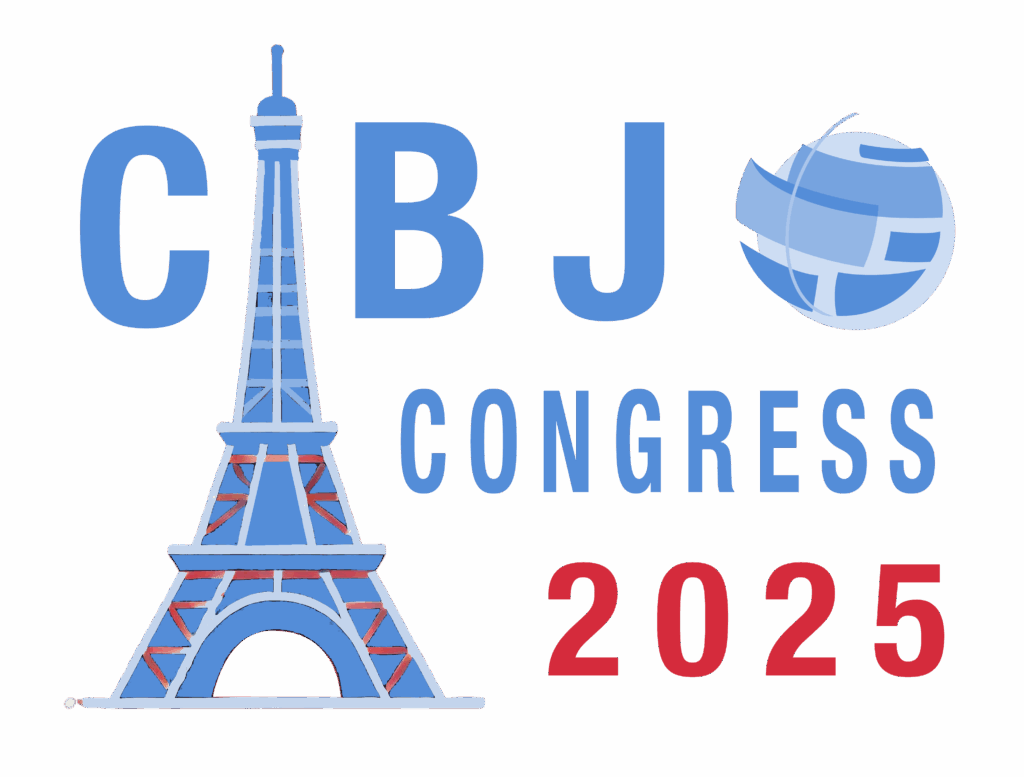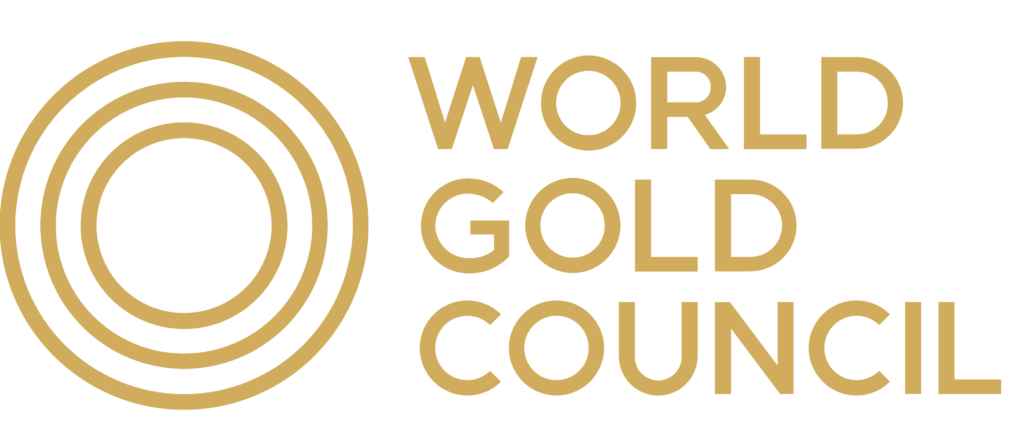SPECIAL REPORT
PEARLS
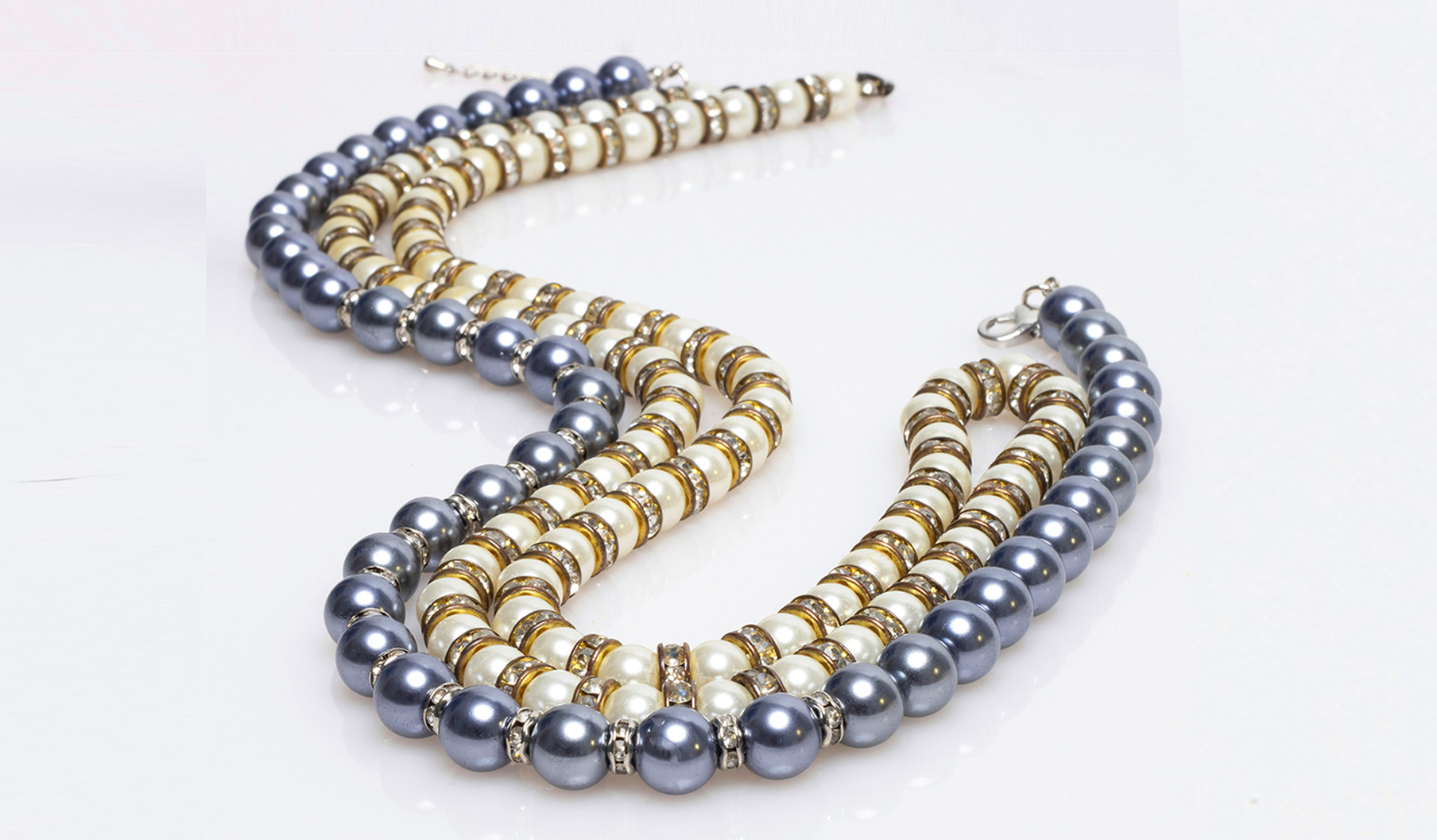
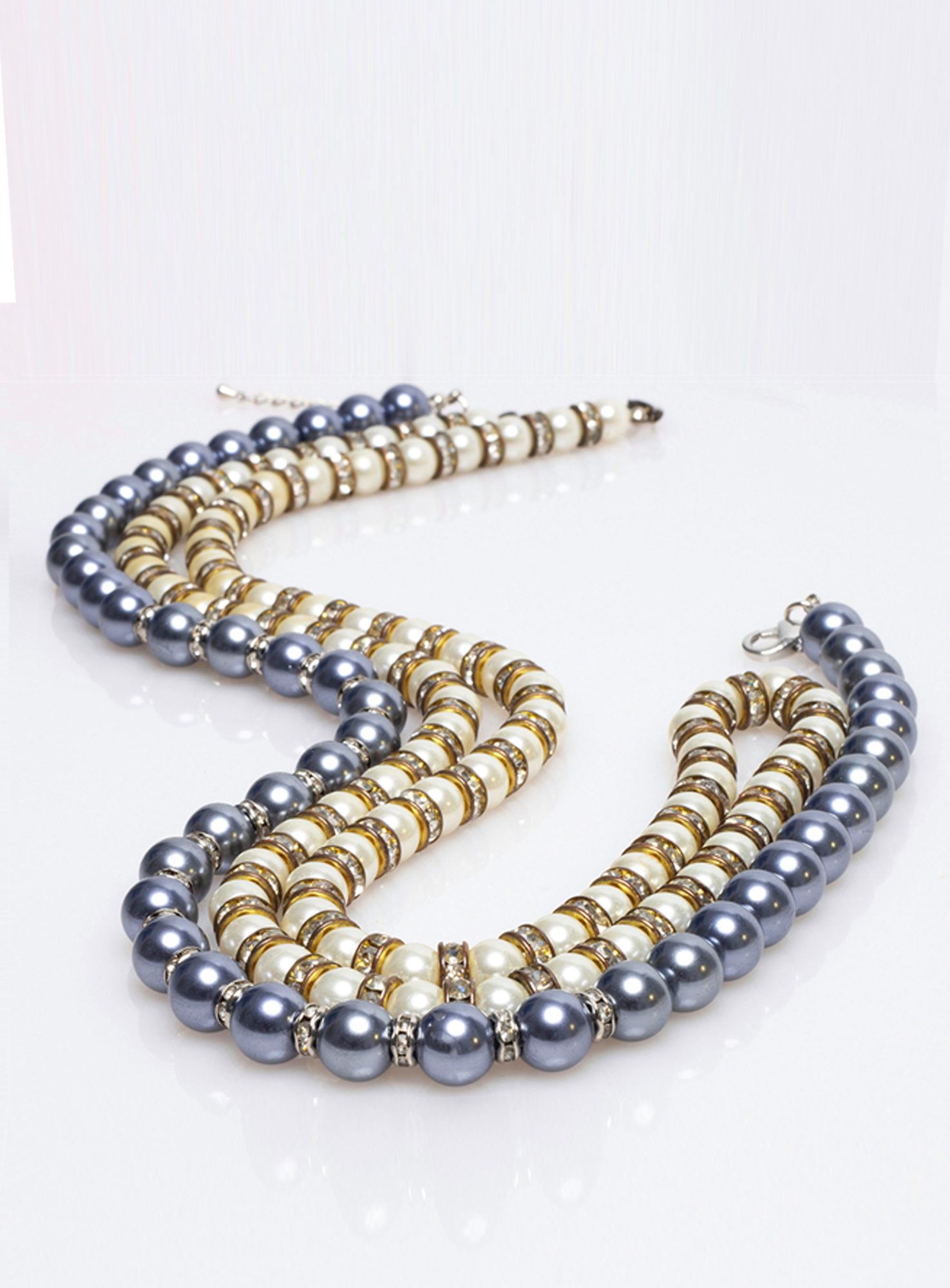
PHOTO CREDIT: Photo by Andrea Guidera on Unsplash
Science underpins the pearl’s quest
to become the first ‘nature-positive’ gem
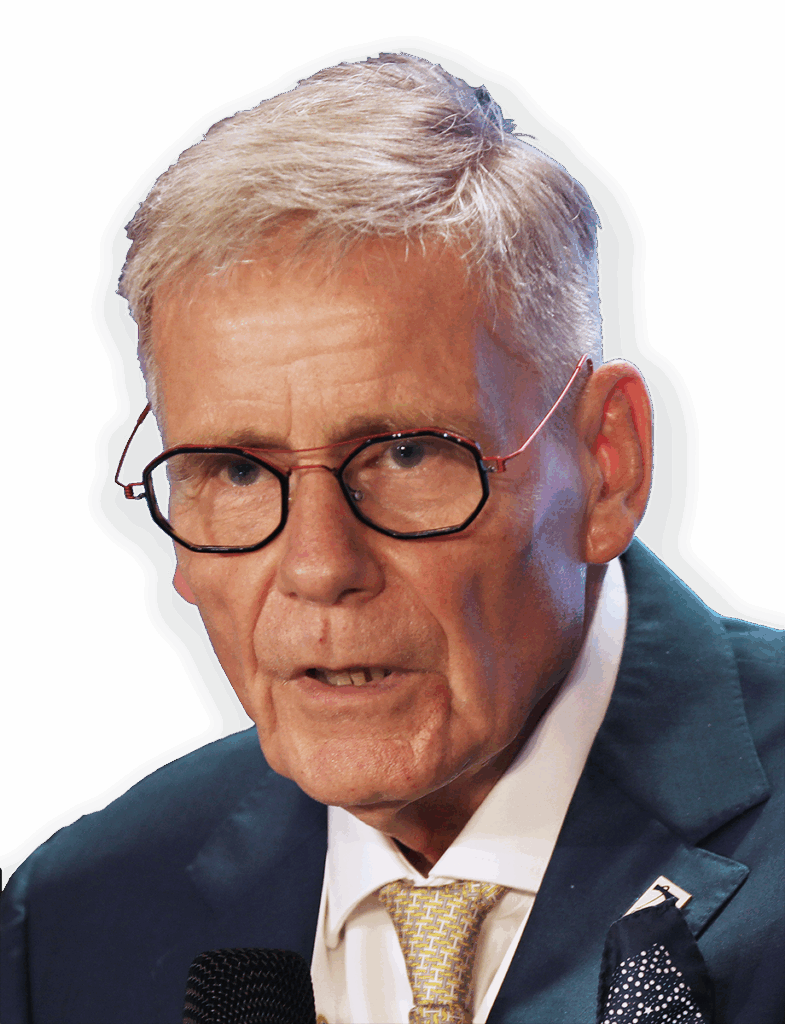
By Kenneth Scarratt
President
CIBJO Pearl Commission
OCTOBER 9, 2025
The pearling community is very special one, with producers, suppliers, merchants and brokers of both the natural and cultured varieties spanning the globe, servicing the public’s ever-growing fascination with pearls.
This industry today is supported by an expanding body of scientific expertise, which seeks to assist in and ensure that it is not only one of the most responsible jewellery sectors, but also is among its most operationally transparent.
Pearls have held a special place in the World Jewellery Confederation, since our organisation was created in its original form 99 years ago. The acronym CIBJO, by which our association is better known, comes from French term Confédération International de la Bijouterie, Joaillerie, Orfèvrerie des Diamants, Perles et Pierres, which in English translates as “International Confederation of Jewellery, Silverware, Diamonds, Pearls and Stones.” So, pearls, together diamonds and coloured stones, therefore, were very much the full focus when CIBJO first reported on its deliberations on terminology and trade practices in 1968. The three main elements, while being separate and distinct from each other, together still form the fundamental staple of the gem-set jewellery industry, and they are why CIBJO exists today.
In opening this report, we need to enthusiastically acknowledge all of our predecessors within the CIBJO family who have gradually, over 100 years of debate, deliberation and gradually-arrived-at agreements, shown us how to maintain and develop appreciation of one of the most beautiful products on our planet — the pearl.
“How could you reach the pearl by only looking at the sea? If you seek the pearl, be a diver,” purportedly wrote Rumi, the 13th Century Sufi mystic and poet. What he was telling us is that one needs to act if you are to achieve something valuable. This is what we try to do in the CIBJO Pearl Commission.
In doing do so, we have enjoyed the benefit of standing on the shoulders of the industry giants who came before us. As they did, we constantly observe and record this amazing industry, which continues to deliver.
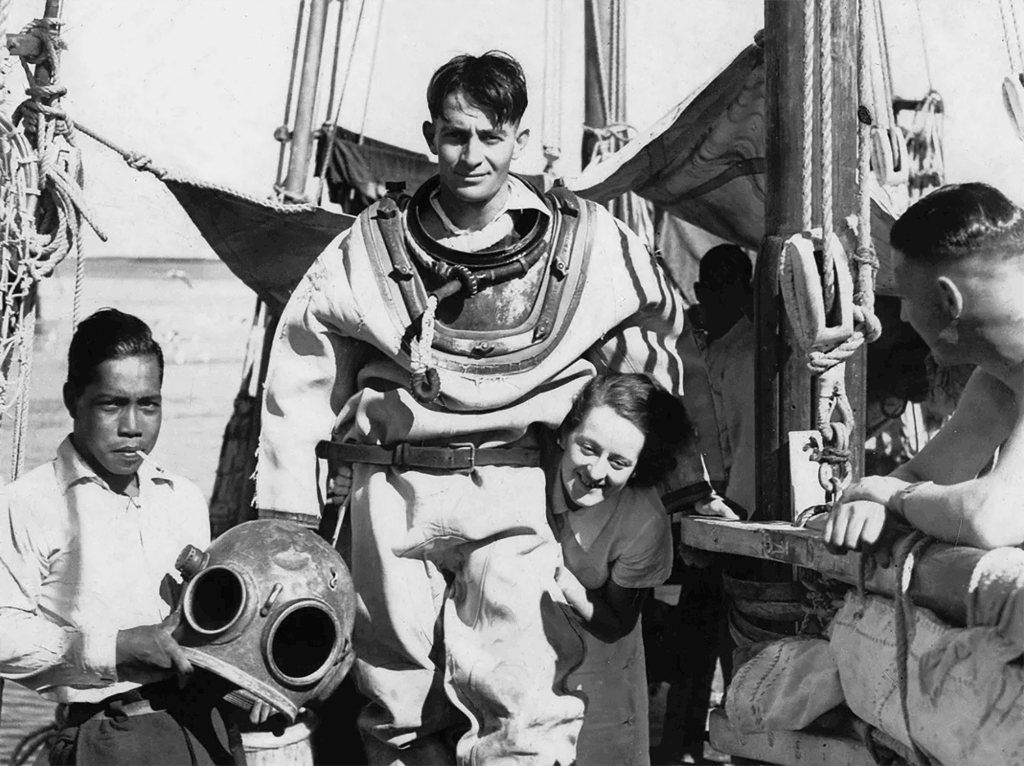
Wearing the diving suit is Nicholas Paspaley MBE, the founder of the Australian pearling company of the same name, together with his sister and members of his team in 1937. His son and namesake, Nick, today heads the company that pioneered the South Sea pearl industry.
There are many trailblazers to which we all owe a debt, but in this year’s special report I would like acknowledge the 90-year quest — first for natural, and then cultured pearls — by the Australian pearling company, Paspaley. Nicolas Paspaley, the son of its founder, still serves on the CIBJO Board of Directors, and his nephew, Peter Bracher, is a Vice President of the Pearl Commission. We congratulate the family, and thank them for their service to CIBJO.
Natural pearling has an history of many thousands of years, but modern innovations, which were developed particularly over the last 100 years, have made pearl treasures accessible to all those who appreciate fineness and beauty.
The 2025 Pearl Special report provides a broad overview of our sectors, with contributions with some of our commission’s dedicated members.
Work of the Pearl Commission after CIBJO Congress 2024
During the very successful 2024 Shanghai Congress the CIBJO Pearl Commission busied itself with making a few small edits to the Pearl Blue Book. These were approved and the updated document can now be downloaded at no cost from the CIBJO website at https://cibjo.org/wp-content/uploads/2024/11/2024-Pearl-Book-Nov-3.pdf.
The commission was also tasked with the formation of a working group to update and expand upon the CIBJO Pearl Guide which was first published in 2021 and subsequently translated into Thai, Japanese, French and Italian. The group was formed after the congress, and immediately began the process, expanding the original 62-page document into a well-illustrated 267-page educational guide. It is titled “Describing and Classifying Natural and Cultured Pearls, the Producing Molluscs and Responsible Pearling), and is awaiting publication.
The new “Pearl Guide” has now incorporated the document “the Environmental, Social and Economic Impact of Natural and Cultured Pearls, which originally appeared as a separate guide on the CIBJO website. During its incorporation into the new document, the Pearl Sustainability section was further expanded to include “Impact Case Studies,” which provide an overview of the social and environmental impact of pearling and pearl farming on various countries and pearl types. The information in this new section covers achievements and on-going initiatives which are either publicly available or have been provided by stakeholders. The purpose of this overview is to inform, inspire the industry, and engage the whole pearl value chain towards better practices.
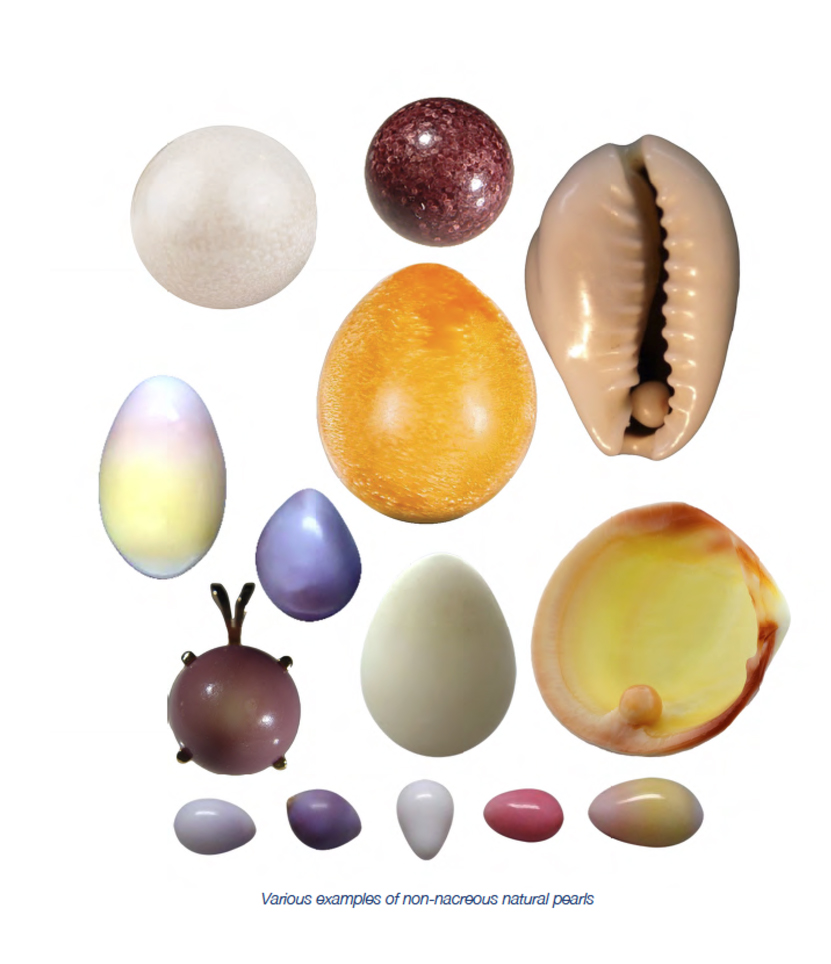
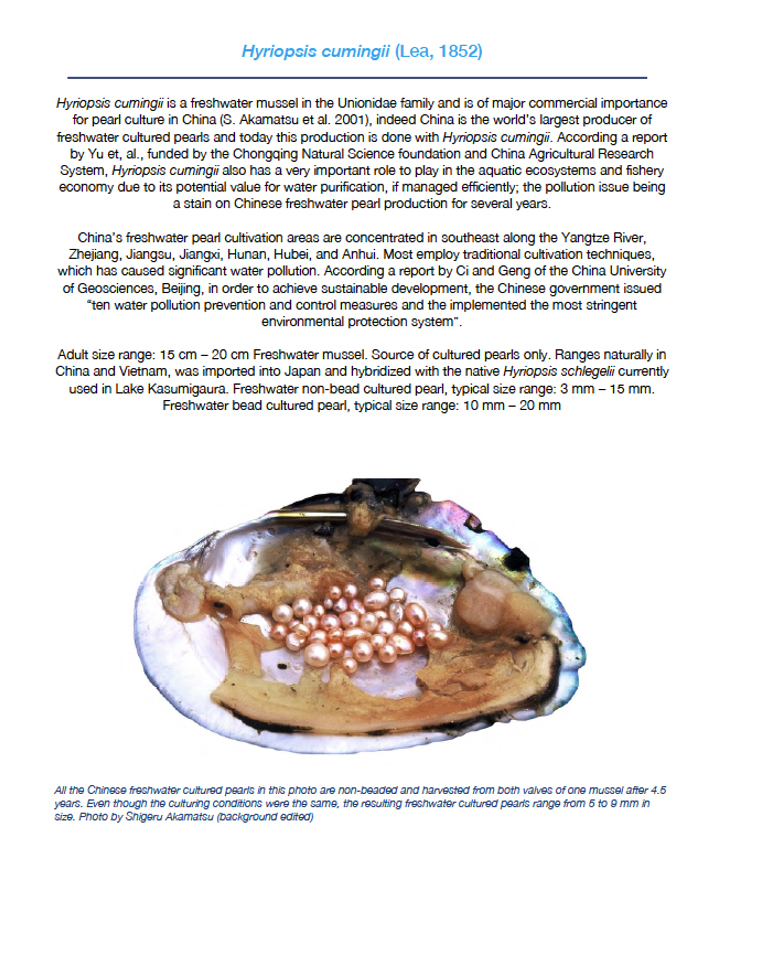
Pages from the new CIBJO Pearl Guide.
The guide describes and illustrates 43 pearl-producing saltwater nacreous and non-nacreous bivalves in alphabetical order, many of which will be new to even those involved professionally in the pearl industry. It also describes 23 pearl-producing saltwater nacreous and non-nacreous univalves, followed by 27 freshwater bivalves that are producers of nacreous (sometimes non-nacreous) natural and cultured pearls, as well as natural blisters, blister pearls and cultured blisters.
The new guide also delves into pearl classifications. Noting that currently CIBJO does not have its own classification system for natural or cultured pearls, nor does it endorse one industry system over another, this section describes five different systems, noting the differences between “pearl classification” and “pearl grading.” This it followed with a general overview of saltwater and freshwater cultured pearl types, that explores their species, origins, characteristics and methods of production.
The guide illustrates and explains the meaning of the term “keshi,” and also looks at artistic impressions using atypical beaded cultured pearls. A whole section is devoted to the processes and treatments applied to natural and cultured pearls.
The guide contains an extensive terms and definitions section as well as a comprehensive list of references.
We anticipate that the guide will be published shortly. CIBJO and the Pearl Commission are truly grateful to the dedication of the Working Group members, who managed to produce an extensive document between two congresses. Theirs was truly a truly mammoth task.
Global Pearl Development Community (GPDC)
The Global Pearl Community (GPDC) was officially launched on September 19, 2025, at its inaugural general assembly in Hong Kong, as a non-governmental organisation uniting pearl producers, trade associations and industry stakeholders, across the saltwater and freshwater sectors.
The new body was jointly initiated by leading organisations in the jewellery trade, including the World Jewellery Confederation (CIBJO), the Gems and Jewellery Trade Association of China (GAC), the Japan Pearl Promotion Society (JPPS), and the Thai Gem and Jewelry Traders Association (TGJTA), among others.
GPDC’s mission is to foster international collaboration, standardisation, sustainability, and innovation across the pearl value chain.
The organisation aims to consolidate resources, promote ethical practices, and elevate global awareness of the pearl industry, with its overarching goal being be to build a global pearl industry ecosystem that covers farming, processing, trade and culture. GPDC’s formation marks a significant milestone in unifying the sector and driving long-term growth through shared values and strategic cooperation.
The meeting was attended by CIBJO President Dr. Gaetano Cavallieri, who was asked to deliver a keynote address.
Dr. Cavalieri highlighted the extensive work undertaken by the CIBJO Pearl Commission in standardising pearl nomenclature and classification within the industry. He referenced the commission’s efforts that are reflected in the Pearl Blue Book, which sets internationally recognised standards for pearl identification, and terminology, as well as the forthcoming updated edition of their Pearl Guide. These publications address key issues such as defining criteria for different pearl types, ensuring accurate descriptions, and offering clear guidelines to promote consumer transparency and trust.
Dr. Cavalieri also acknowledged the core objectives of the Global Pearl Development Community (GPDC), which include fostering information shared across the global pearl industry, aligning standards for classification and sustainability, promoting pearl culture through international campaigns, diversifying trade platforms, and advancing digital innovation. He emphasised the alignment between CIBJO’s mission and the GPDC’s goals, and he formally invited GPDC members to collaborate with CIBJO in driving sector growth and enhancing consumer protection.
To achieve this, the GPDC will act in collaboration with the CIBJO Pearl Commission and align with the CIBJO international standards set out in both the CIBJO Pearl Blue Book and the CIBJO Pearl Guide. This will make it possible to nurture in-depth collaboration among its members in areas such as technological innovation, industrial upgrading, self-regulation, brand development and sustainable practices. Diverse market opportunities and cultural experiences will enable consumers worldwide to enjoy pearl products of higher quality and greater trustworthiness.
Australian South Sea Pearls: market overview and outlook
Contribution by Peter Bracher, CIBJO Pearl Commission Vice President
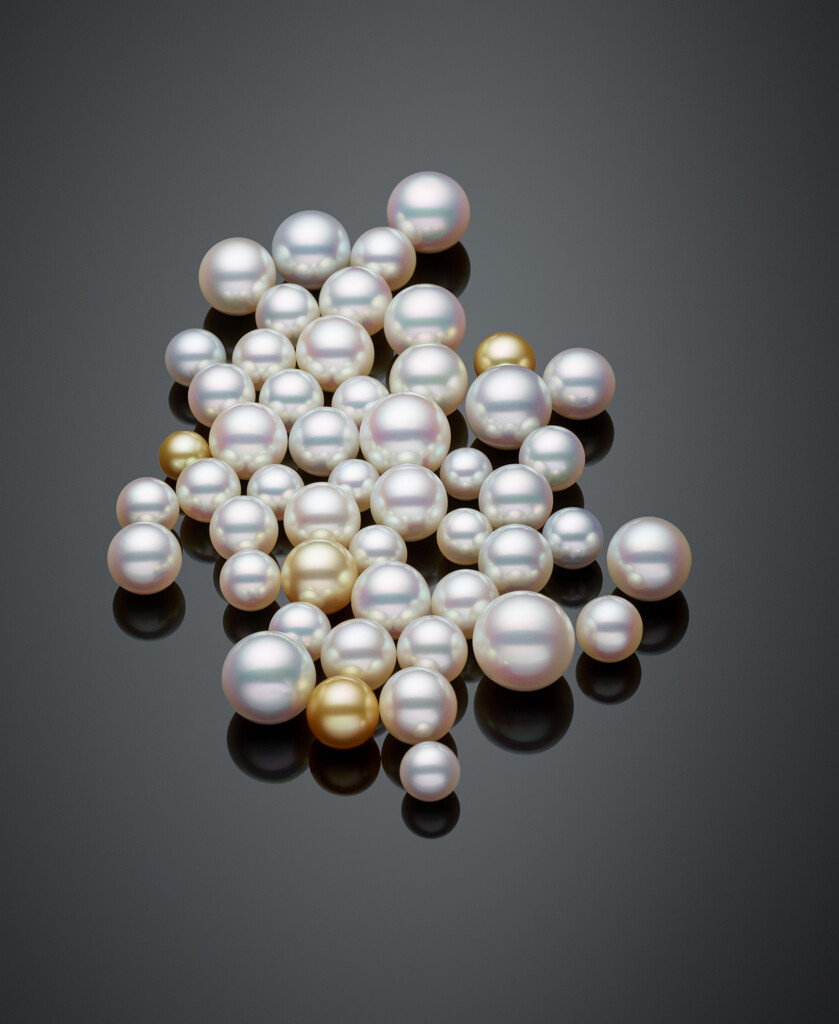
Loose South Sea pearls produced by Paspaley.
The quality, heritage and sustainability of Australian South Sea pearls continue to be an anchor for the global pearl narrative. With an increasing focus on these aspects, combined with innovation, the industry is well-positioned to thrive in the evolving luxury landscape over the coming years.
Market Performance
Demand for Australian South Sea pearls has held steady over the past year, particularly in bespoke and luxury retail channels. While some markets have shown price sensitivity, overall interest remains strong, supported by strategic marketing efforts and expanded distribution to independent jewellers and high-end brands.
The industry continues to navigate challenges presented by tariffs and limited supply of high-quality pearls, while leveraging its reputation for quality and sustainability.
Forecast and Jewellery Trends
Looking ahead, the pearl sector is poised to benefit from a growing consumer appetite for authenticity and sustainability.
Pearls are increasingly featured in contemporary jewellery designs, with baroque shapes and statement pieces gaining traction among younger demographics. This trend is amplified by digital marketing and e-commerce growth, particularly in the Asia-Pacific markets.
Continued investment in ESG credentials, and storytelling around provenance will be key to maintaining momentum.
The monitoring of the Akoya pearl oyster for exposure
to red tides and detecting changes in the ocean
Contribution by Ryuichiro Machizawa
This report introduces the “Kai-lingual,” which is also briefly described in the new CIBJO Pearl Guide.
In inner bay fishing grounds where pearl cultivation is prosperous, the occurrence of red tides, poor oxygenation (oligoaerobic conditions or hypoxic conditions), and anaerobic hydrogen sulfide (hydrogen sulfide-containing oligoaerobic conditions or hypoxic water containing hydrogen sulfide) often causes great damage to fisheries in the summer months. Furthermore, in recent years, the fisheries have been exposed to environment related changes and severe aquaculture environments. For example, a red tide caused by the dinoflagellate Heterocapsa circularisquama, first recorded in 1988, formed a large-scale red tide in Ago Bay in 1992, killing large numbers of Akoya oysters. It has since expanded to the waters of western Japan, often forming red tides in inner bays, causing extensive damage to shellfish farming and other fishing.
This species causes great stress to bivalves such as Akoya pearl oysters, by preventing them from feeding even at a low density of about 50cells/ml, where seawater is not coloured, and is so virulent that it kills bivalves in a short time at a high density of several thousand cells. It was called a new type of red tide in order to distinguish it from the conventional red tide, because the sea water was not coloured.
The Akoya pearl oyster exposed to H. circularisquama immediately exhibits intense opening and closing movements of the shell, trying to eliminate the cells entering the body of the oyster. If this movement can be accurately measured in the actual sea area, it will be effective for the monitoring of this species of red tide.
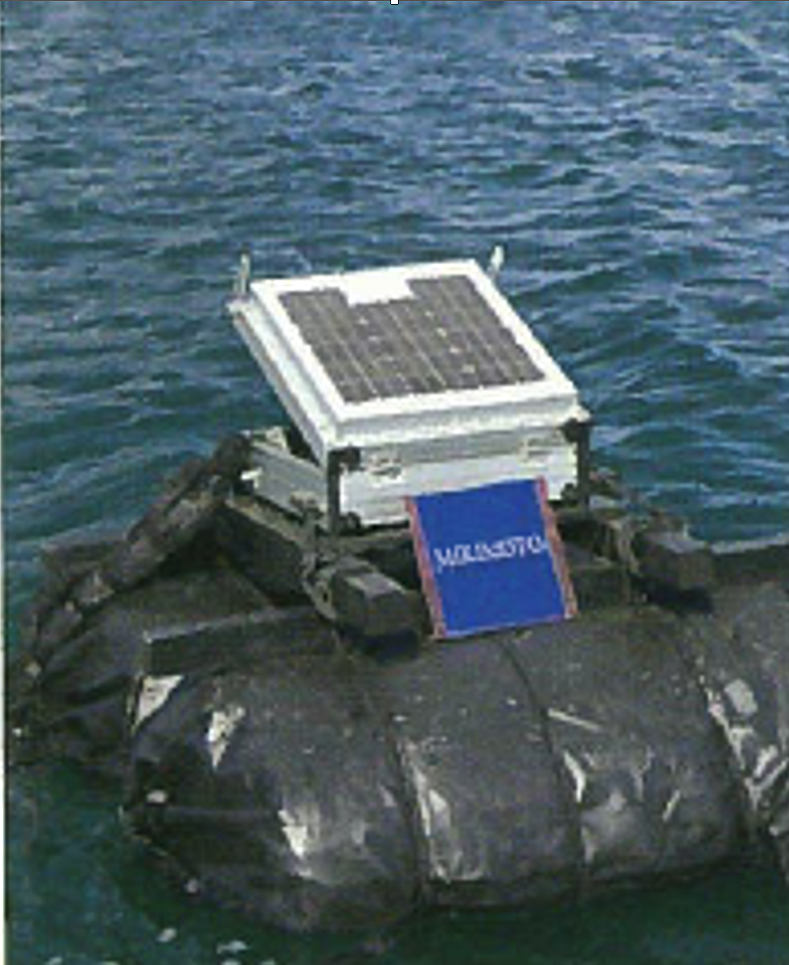
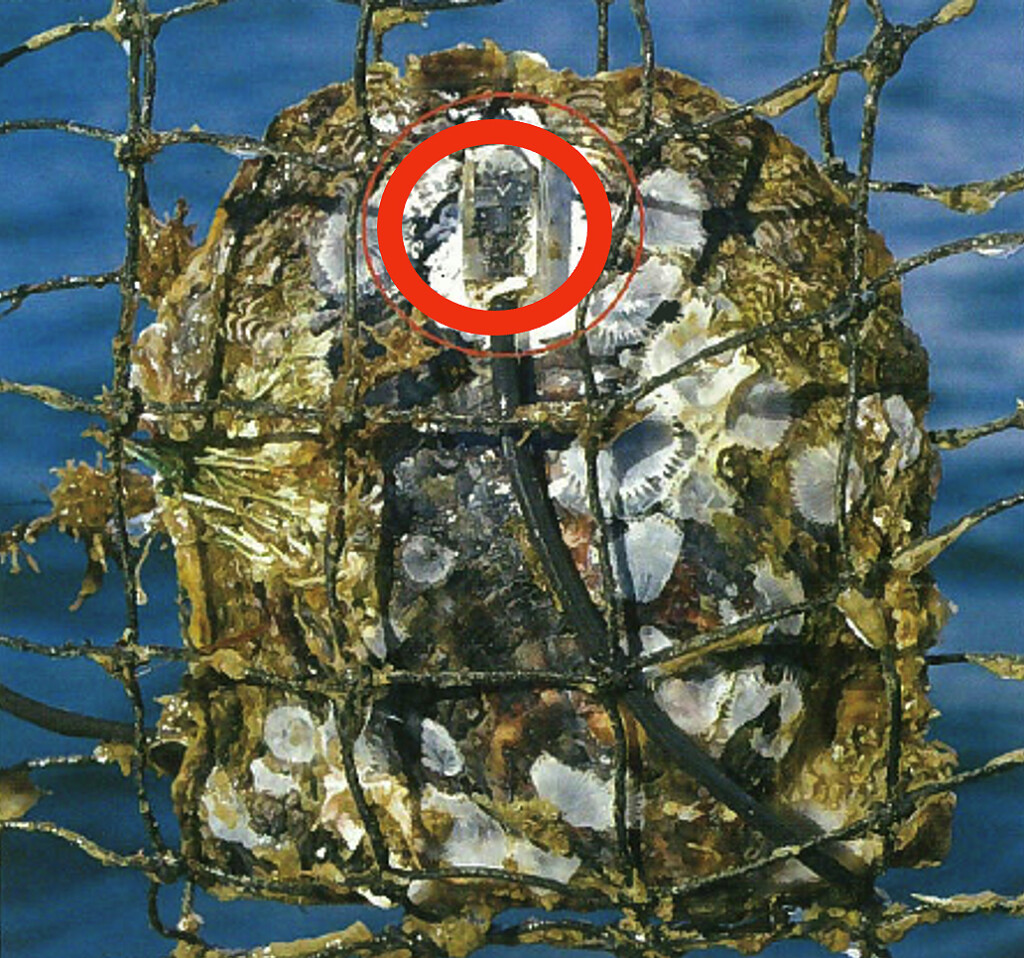
Kai-Lingual, the Mikimoto marine environment monitoring system (left). On the right is the recording biological sensor, the Hall element, visible inside the red circle, attached to the exterior of an Akoya shell.
Kai-Lingual, the Mikimoto marine environment monitoring system (above). Below is the recording biological sensor, the Hall element, visible inside the red circle, attached to the exterior of an Akoya shell.
With this understanding, K. Mikimoto & Co., Ltd. developed “Kai-Lingual (Shell-Lingual: Kai means shell or oyster in Japanese),” a remote environment monitoring system using bivalves. It did so in cooperation with Kyushu University and the Tokyo Sokki Research Institute in 2004.
By attaching a sensor using a “Hall element,” a magnetoelectric transducer, to one shell and attaching a small magnet to the other shell, Kai-lingual can measure the minute movements of the shell. The sensor is small, easy to install, and durable, so that it can accurately measure the opening and closing movement of bivalves in a natural state over a long period of time, and can grasp the state of the bivalves in the sea in real time (Iwahashi 2019; Morelli 2023; Nagai 2008).
Shells react differently depending on the environment, such as red tide, hypoxia, and hydrogen sulfide. By interpreting the responses of shellfish to these various environments, we can learn what is happening in the aquatic environment.
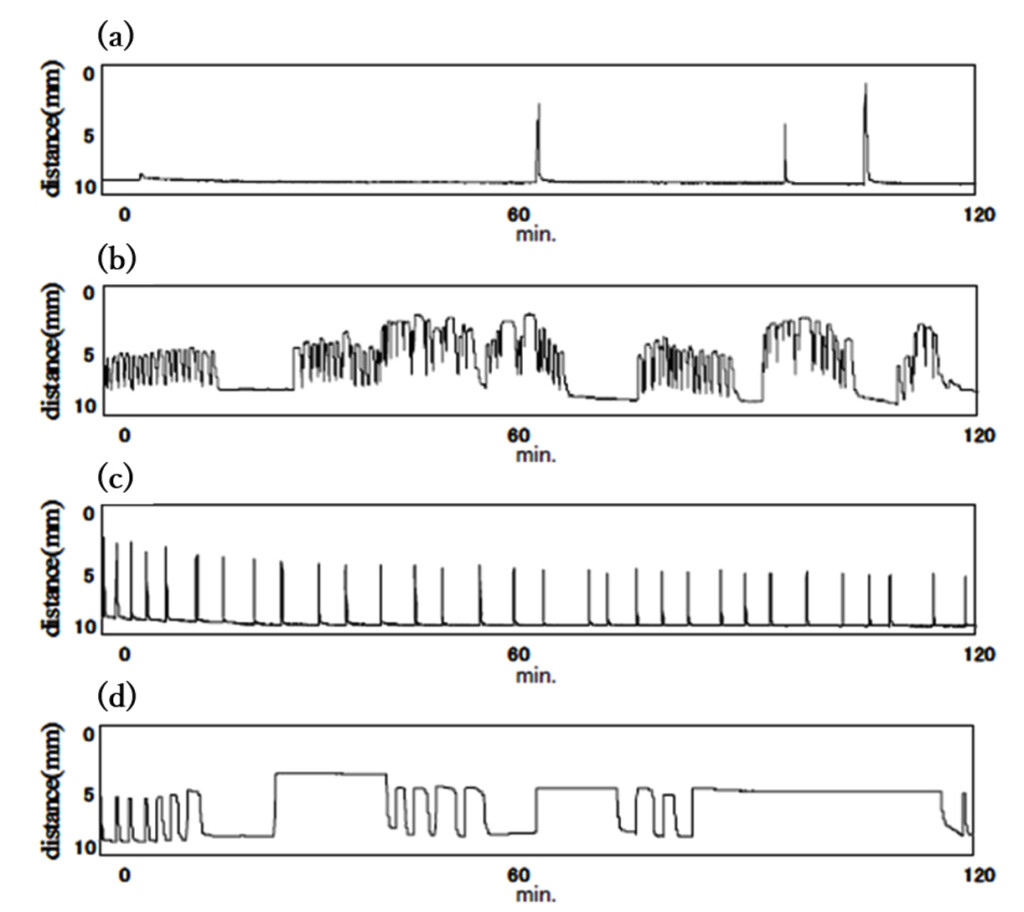
Valve movements recorded for pearl oysters in (a) Normal sea water, (b) Sea water containing H. circularisquama at densities of 50 cells/ml, (c) Hypoxic sea water and (d) Hydrogen sulfide-containing hypoxic sea water.
The Kai-lingual has become a tool to connect marine life and people. In this way, by using the bivalve’s reaction to immediately know the abnormality of the hydrospheric environment, we are able to quickly and appropriately manage the bivalve.
In recent years, the fishery industry has become increasingly smart using advanced information and communications technologies such as the IoT and ICT. The Mikimoto company has been monitoring fishing grounds 24 hours a day since the practical application of the Kai-lingual in 2004. Information on shell lingual observed in Ago Bay is transmitted from the Mie Prefecture Fisheries Research Institute and is used for aquaculture management at local pearl farms.
In addition, the shell lingual of the new model in 2024 is capable of advanced analysis. By deciphering the detailed environmental response of shellfish provided by this new model, various abnormalities in the aquatic environment that we do not know yet may be clarified.
Whole and spherical cultured pearls
from the abalone (genus Haliotis)
Contribution by Shigeru Akamatsu, CIBJO Pearl Commission Vice President
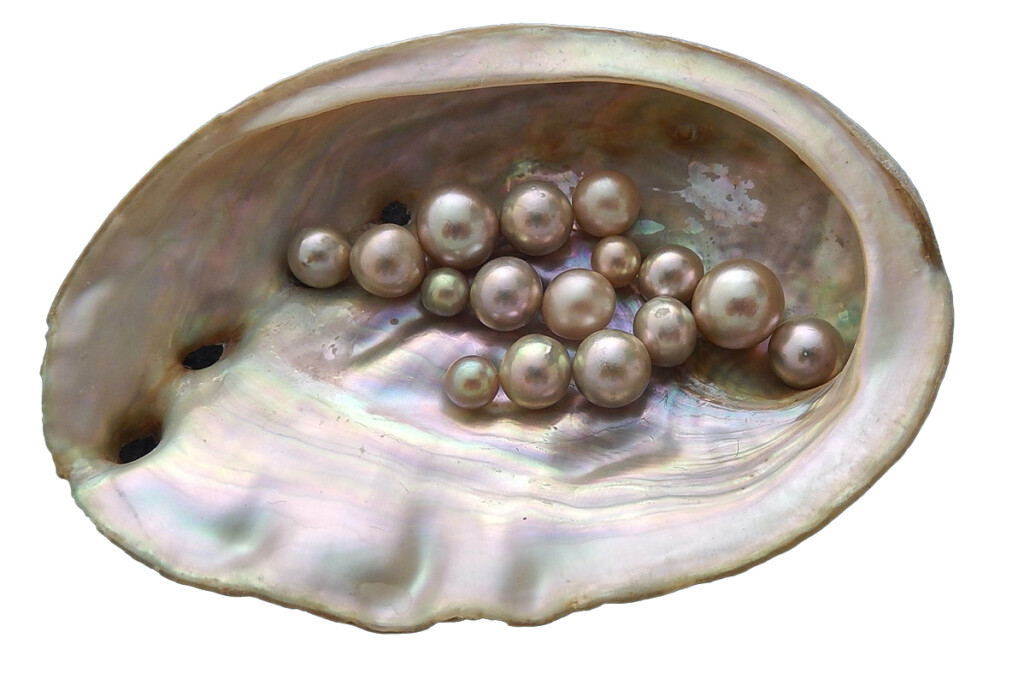
Near-round Abalone cultured pearls. (Photo: Shigeru Akamatsu)
A pearl cultivator in Nagasaki has developed a new method for the culturing of almost perfectly spherical abalone pearls.
The method consists of three or more parts. The abalone are firstly anaesthetised, and the first nucleus insertion operation is performed for the purpose of creating a cultured pearl sac. Small sized beads, circa 3 mm, are inserted in the mantle of the anaesthetised abalone.
After culturing for one year, a second operation is performed for the purpose of pearl production. Without killing the abalone, a pearl is pulled out from the cultured pearl sac constructed in the mantle, and then a larger bead is inserted into the vacant cultured pearl sac. The sac continues the pearl culturing process.
By repeating this operation more times, larger and more spherical pearls can be obtained.
The resulting cultured pearls meet the standards for jewellery in terms of all the quality factors: shape, nacre thickness, flaw, lustre and colour.
Although this new abalone pearl culturing technique is currently experimental, as production increases it is anticipated that this product will be accepted in the market as a new category of cultured pearl jewellery.
Paving the way from pearl impact to value
Contribution by Pierre Fallourd
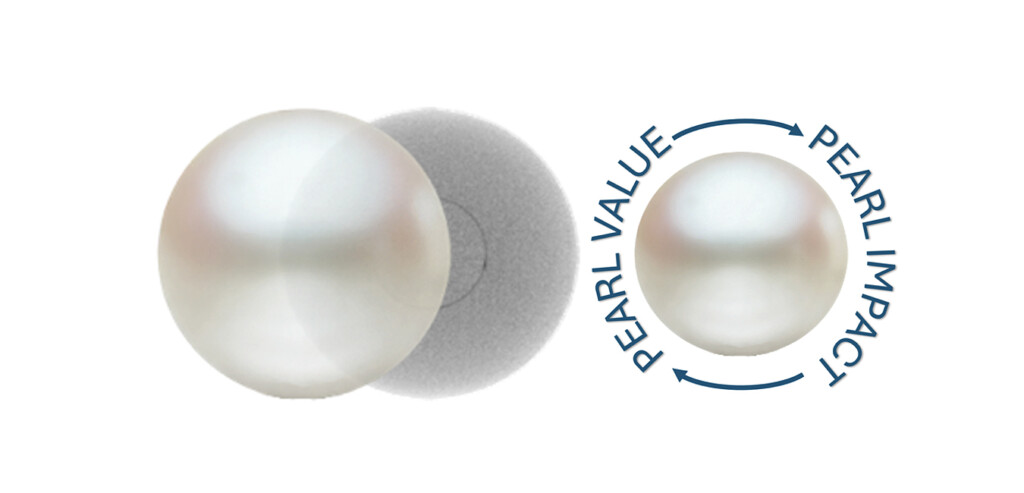
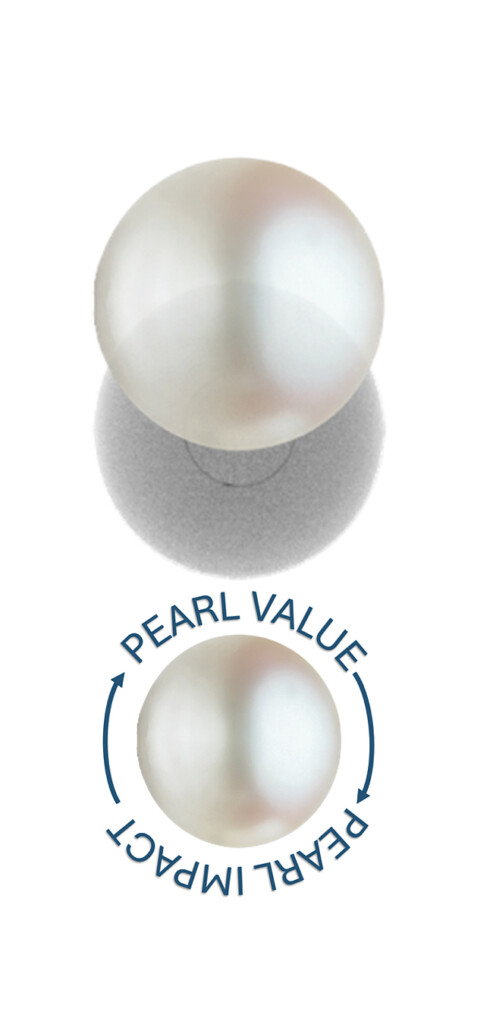
The value of pearl impact: It’s not the destination, it’s the journey.
Can the social and environmental impact of pearls drive their value up?
A tech-savvy generation of consumers have been reshaping the jewellery industry following the global pandemic. Reputation and trust are being replaced by transparency and traceability, while voluntary Corporate Social Responsibility (CSR) efforts shift to financial Environmental, Social and Governance (ESG) standards. Code of Practice (CoP) and Chain of Custody (CoC) protocols have become standard, and technology now enables unique credentials for individual products beyond category certification.
Pearls are traditionally valued based on physical attributes which reflect the journey of the mollusc, as it grew within its aquatic environment. There is therefore a natural incentive for pearlers and farmers to look after their people and the molluscs which will grow pearls.
Many producing countries and companies have exceeded their legally dictated compliance requirements, and created voluntary social and environmental Code of Practices to guide responsible pearlers and pearl farmers.
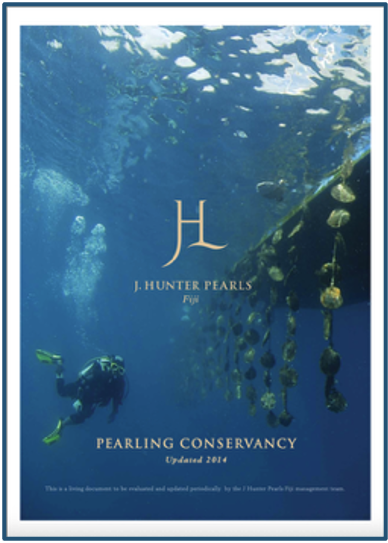
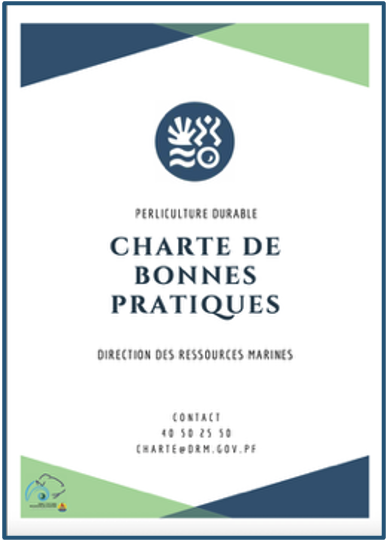
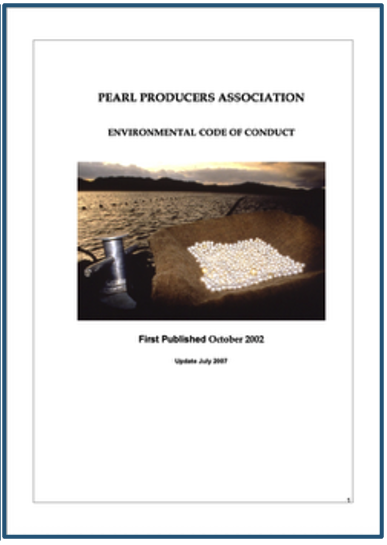
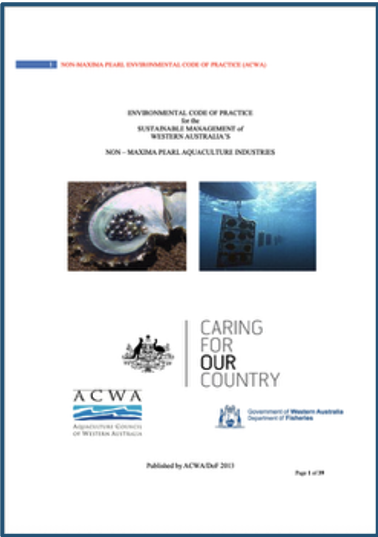
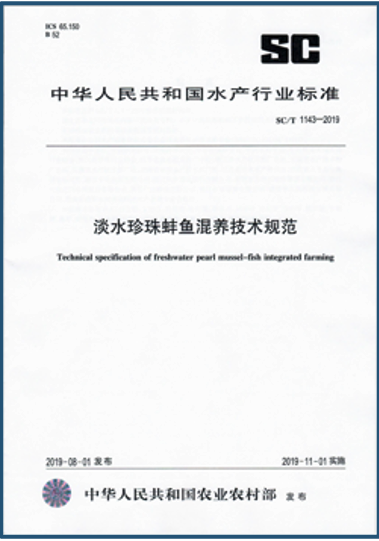
Examples of Code of Practices. Left to right: J.Hunter; Fiji; Direction des Resources Marines, French Polynesia; Pearl Producers Association, Australia; Aquaculture Council of Western Australia (non-maxima), Australia; Agricultural Standard Publishing Research Center, China.
Examples of Code of Practices. top top bottom: J.Hunter; Fiji; Direction des Resources Marines, French Polynesia; Pearl Producers Association, Australia; Aquaculture Council of Western Australia (non-maxima), Australia; Agricultural Standard Publishing Research Center, China.
Industry players and stakeholders acknowledge that increased transparency around geographical origin and social and environmental impact can deliver substantial value, ranging from social licence to operate to enhancing natural capital, all of which may also amplify storytelling at retail level. Natural capital, it should be noted, consists of four categories of ecosystem services: provisioning, regulating, supporting and natural capital, all of which may amplify storytelling at retail level
Could pearls become the first “nature-positive” gems?
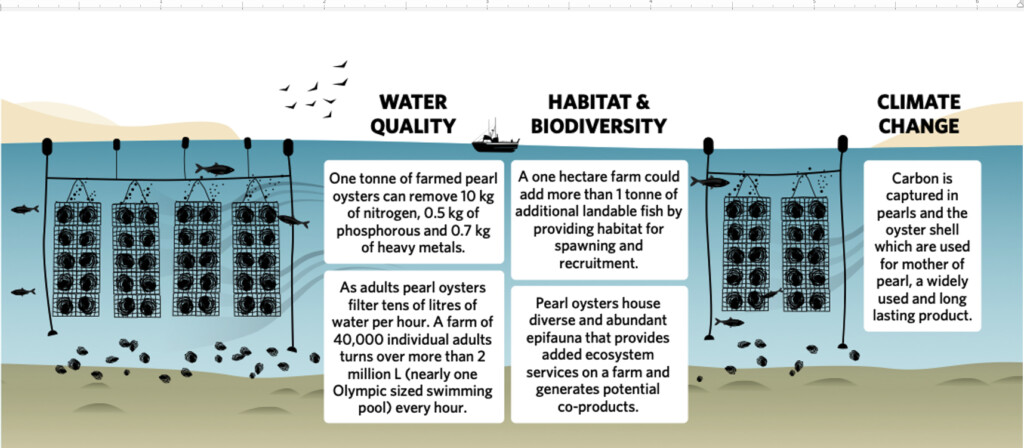
Source: Marine Pearl Farming, a case study for regenerative and restorative aquaculture credits @The Nature Conservancy.
CLIMATE CHANGE
The results of Life Cycle Assessments (LCA) conducted in Japan and Australia have pointed to a very low emission footprint ranging from a few grams to a few kilos of CO2 equivalent per pearl. In contrast (1 kg CO2 E = 3 km by car, 100 km by train, 6 rolls of toilet paper or 2.3 g of sugar – source carbotech.com). Using a conservative 1 kg of CO2 per pearl, 10,000 pearls harvested per hectare and carbon credit sitting at US$100 per ton, it would cost US$1000 to offset one hectare of pearl farm, or a few cents per pearl.
WATER QUALITY
Oysters are feeding on nutrients which in excess can lead to ocean eutrophication, harmful algal blooms and oxygen depletion and shifts in species composition. Assuming one hectare of pearl farm delivers 5 tons of oysters which removed 50 kg of nitrogen valued at $100/ kg and 2.5 kg of phosphorus valued at $500/ kg, total bio-extraction equivalent value would be US$6250.
HABITAT & BIODIVERSITY
Farming equipment such as ropes, basket and nets hosting the oysters, and also the oysters themselves, provide support, shelter and food, boosting biodiversity. Studies estimate the value of catchable fish in oyster suitable marine environment to range from $1000 to $5000 per hectare. We will assume the average of $2500/ ha. for the purpose of the exercise.
RESOURCES & LIVELIHOOD
In addition, pearling and pearl-farming are labour-intensive and create direct skilled employment in often remotely located areas, which can be complemented by education and empowerment opportunities for surrounding communities. Labour cost attached to one hectare of pearl farm alone can account for up to 30 percent of pearl revenue generated.
Marine pearl farming impact profile varies greatly depending on cultivated species, methods and environment, but the assumptions above support its nature net-positive potential where benefits value exceeds cost to community and ecosystems.
Further species and location specific measurement pilots projects are needed to confirm the following estimates and consider recording their value to community in a balance sheet alongside with the economic value of the organisation considered.
How can this value be realised?
Demonstrating value to ecosystems and community may provide a variety of benefits to producers, such as the social and environmental license to operate, gains in productivity and more. The same is true for traders and retailers, since enable compliance and promote storytelling, which is critical to any marketing effort.
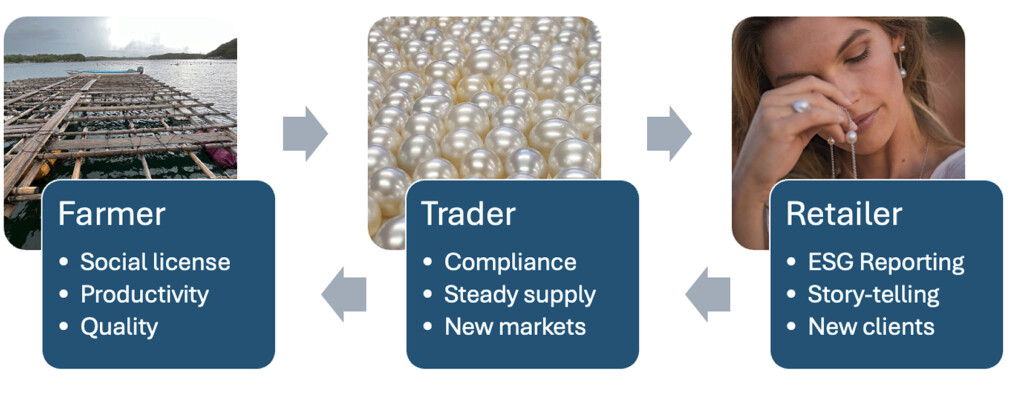
The collection and processing of consistent data present significant challenges, given the complexity and length of the value chain. Track-and-trace initiatives are designed to associate products with verified sustainability credentials.
Meanwhile, discussion has also started to establish a global framework and reporting system that accommodates the transparency requirements of retailers ,as well as the needs of small, non-vertically integrated farmers.
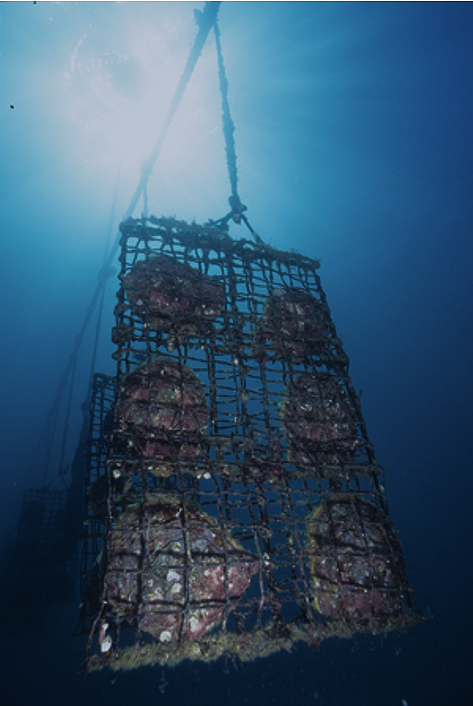
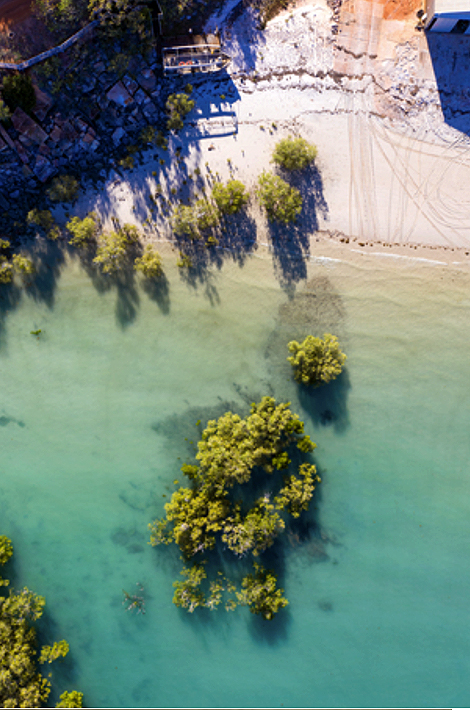
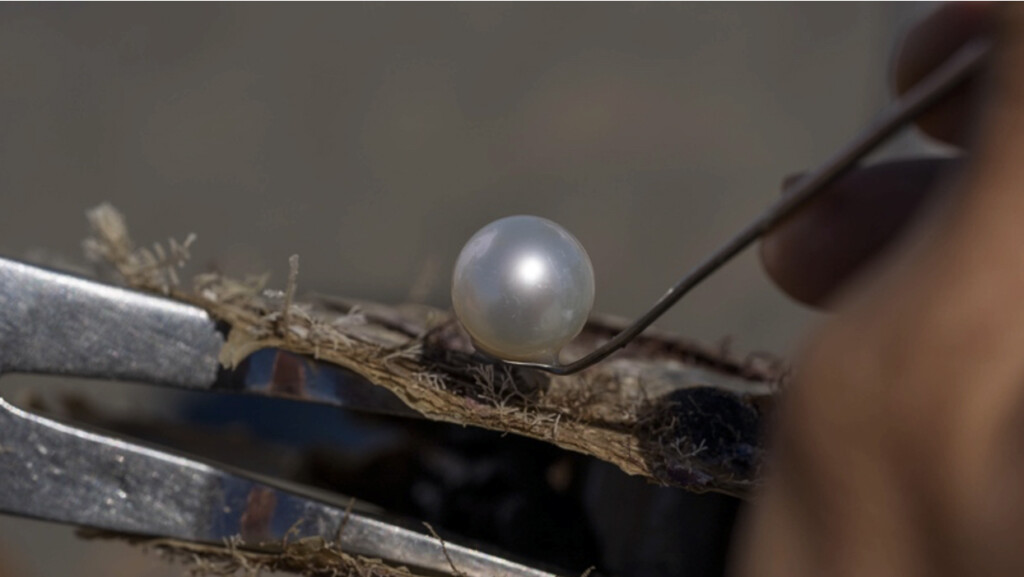
Clockwise: Pinctada maxima hanging in net, the mangrove at high tide, and a White South Sea cultured pearl being harvested. Photos from the Cygnet Bay Pearl Farm, Western Australia.
From top to bottom: Pinctada maxima hanging in net, the mangrove at high tide, and a White South Sea cultured pearl being harvested. Photos from the Cygnet Bay Pearl Farm, Western Australia.
The following projects are contributing to the process:
Onegemme, a B2B trading platform for single origin pearls, partnered in 2024 with Provenance Proof — a blockchain traceability service from the Gübelin Gem Lab in Switzerland — to provide transparent origin tracking and social and environmental impact profile. Each pearl sold includes a transferable provenance certificate, impact profile, and a detailed description.
The World Jewellery Confederation (CIBJO) is adding a 10-page section on sustainability initiatives by cultured pearl producing countries to its Pearl Guide, to be presented at the October congress in Paris. This addition builds on previous content about responsible pearling and its community and environmental benefits introduced in Shanghai in 2024.
The Gemological Institute of America (GIA) introduced in May 2025 a nacre continuity scale, which refers to the thickness and evenness of the layers that form on a pearl to complement its pearl classification system.
Last but not least, the Pearl Association of America, which until recently was known as the Cultured Pearl Association of America (CPAA), has refocuses its efforts on immersive education with the inclusion of natural pearls and overhauling of its digital course “Pearls As One”. The association intends to include various experience based, hands-on pearl activities in collaboration with the industry such as farm visits and gemmological skills acquisition.
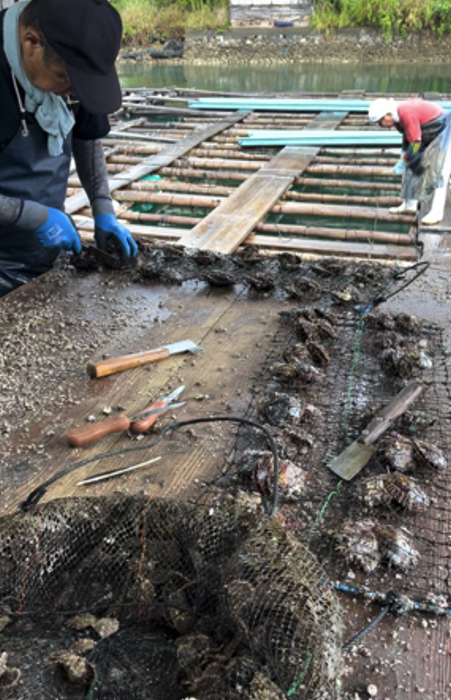
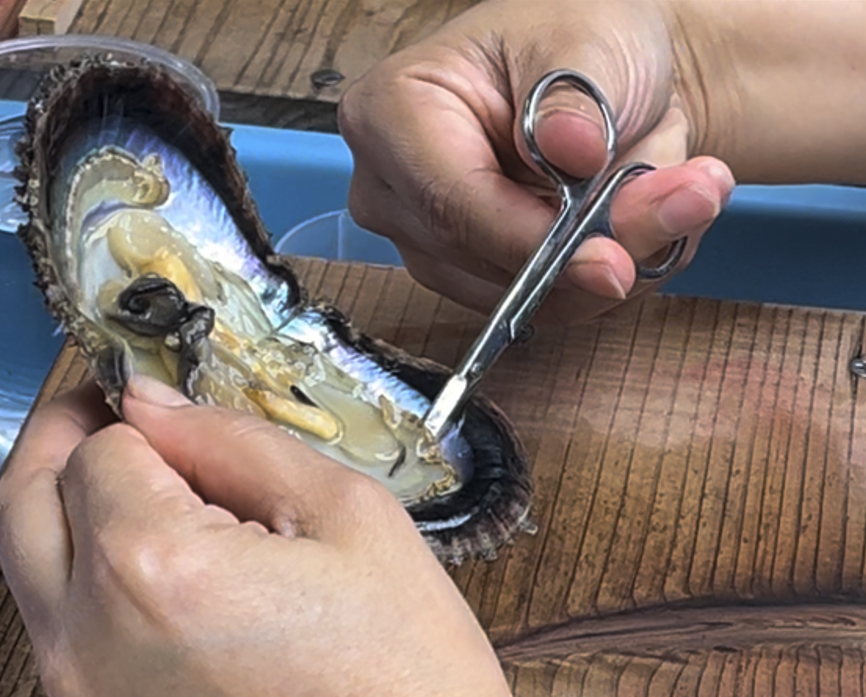
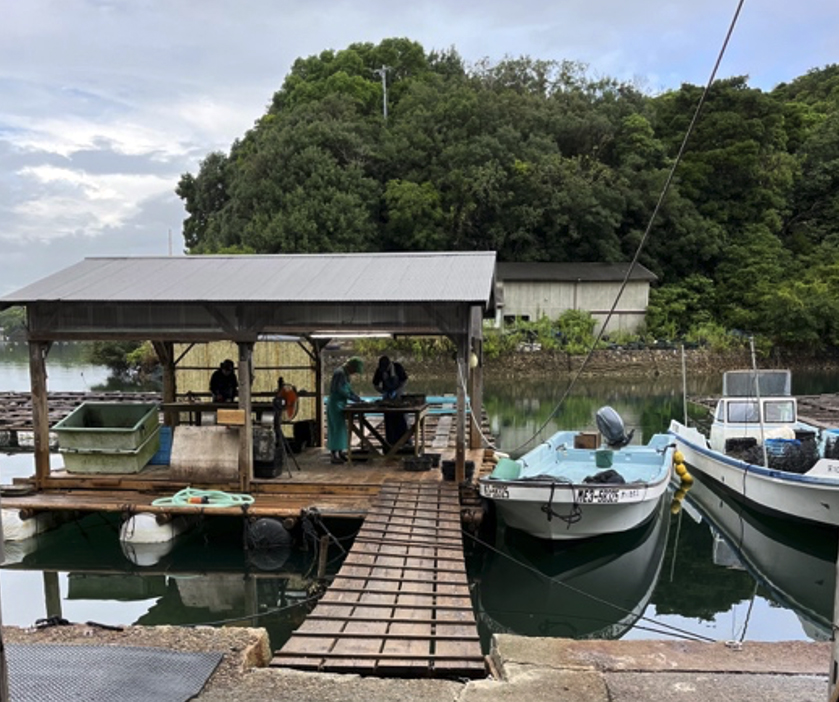
Clockwise: Oyster cleaning and grading, mantle cutting, and an Akoya cultured farm working raft. All photos by Pierre Fallourd, Ago Bay, Mie Prefecture, Japan.
From top to bottom: Oyster cleaning and grading, mantle cutting, and an Akoya cultured farm working raft. All photos by Pierre Fallourd, Ago Bay, Mie Prefecture, Japan.
Collectively, the industry evolution highlights how a mollusc’s journey and associated best practices not only shapes a pearl’s physical traits but also how social and environmental factors can support its value all the way through the supply chain.
Gemmological laboratory pearling observations
Contribution by Gemological Institute of America (GIA)
TRACE ELEMENTAL ANALYSIS OF PEARLS USING MACHINE LEARNING
GIA scientists recently explored the application of several machine learning models to gemstone classification problems involving natural alexandrite, synthetic diamonds, and natural saltwater pearls (Hardman 2024). Laser ablation–inductively coupled plasma–mass spectrometry (LA-ICP-MS) has been employed to analyse the trace element composition of a gem material to determine geographic provenance.
Machine learning enables the rapid exploration of large, complex datasets in new ways. Hence, the application of machine learning algorithms may complement existing microscopic, spectroscopic, and geochemical approaches.
One of the case studies involved separating different groups of natural saltwater pearls. To evaluate whether the provenance of saltwater pearls can be determined, the authors compiled trace element compositions measured by LA-ICP-MS for a set of 604 natural saltwater pearls sampled from Oman, Bahrain and Kuwait, all sourced from local pearl divers. The Bahraini and Kuwaiti pearls reportedly originated from Pinctada radiata molluscs from the Persian Gulf, while the Omani pearls were derived from Pinctada margaritifera molluscs in the region of the Gulf of Oman. Most of these pearls were nacreous while some exhibit non-nacreous surface characteristics.
Trace element compositions were determined using a Thermo Fisher Scientific iCAP Qc ICP-MS coupled with a New Wave Research UP-213 laser ablation unit. Between three and five spots on each sample were analysed and the compositions of six elements (sodium, magnesium, potassium, manganese, strontium, and barium) were found to be particularly useful in this study.
An initial step is dataset simplification, particularly if the dataset contains many samples, each with a large number of variables. Principal component analysis (PCA) and linear discriminant analysis (LDA) are techniques that can simplify a dataset by projecting the relationships between many variables onto fewer dimensions for easier interpretation. The dataset can then be visualized using bivariate scatterplots with the transformed variables as axes, or PCA or LDA can be used to preprocess a dataset for subsequent use in more complex machine learning models.
The results indicated that pearls reportedly fished from Kuwait and Bahrain (with relatively close spatial proximity) and produced by the same Pinctada radiata mollusc species have similar compositions and overlap. Omani pearls, which were reportedly produced by Pinctada margaritifera molluscs, are separated from Kuwaiti and Bahraini pearls (see A below). The population of Bahraini pearls is broadly bimodal, with one subgroup having strong overlap with Kuwaiti pearls and the other showing elevated magnesium and manganese concentrations (see A below). Moreover, nacreous and non-nacreous pearls differ in composition, with non-nacreous pearls (mostly from Bahrain) having higher magnesium concentrations (see B and C below). The magnesium concentrations of non-nacreous pearls from Bahrain, Kuwait and Oman largely overlap with each other (see C below).
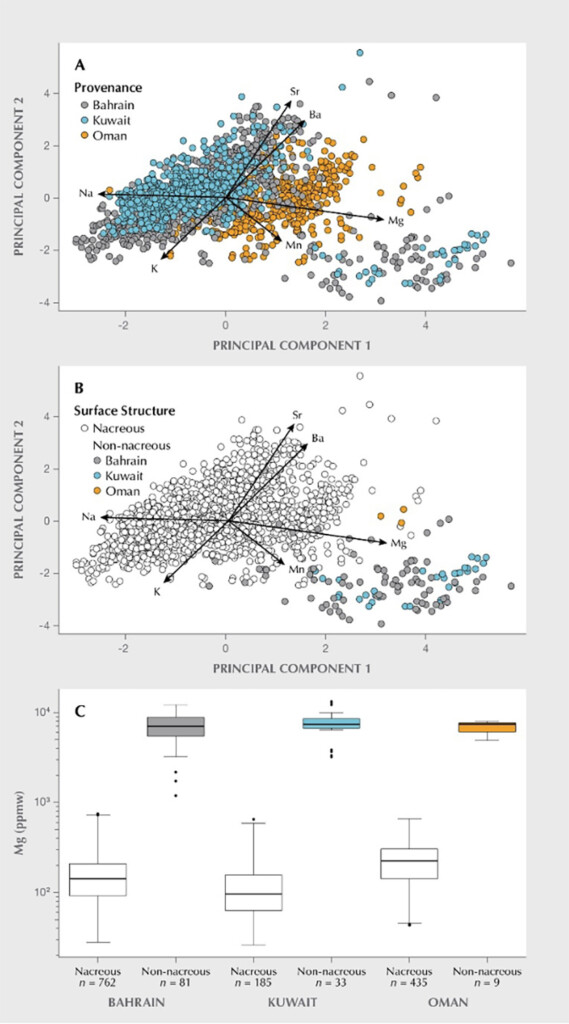
Plot of principal components 1 and 2 for natural saltwater pearls, based on (A) geographic provenance (Bahrain, Kuwait, and Oman) and (B) surface structure (nacreous and non-nacreous). C: Box and whisker plot of magnesium concentrations for all analyses of nacreous and non-nacreous pearls in this study, divided by locality. Solid lines correspond to median values, boxes represent the range from the 1st to 3rd quartile (interquartile range; IQR), the vertical lines are whiskers that range from IQR ± (1.5 × IQR), and the black dots correspond to pearls with values beyond the whiskers, considered to be outliers.
UPDATE ON NACRE CLASSIFICATION WITHIN THE GIA 7 PEARL VALUE FACTORS SYSTEM
Earlier this year, GIA introduced an expanded approach to evaluating nacre on all pearl classification reports, providing an important update to the Institute’s well-established comprehensive pearl classification system, the GIA 7 Pearl Value Factors™. Nacre formation plays a critical role in pearl growth, as its structure influences other value factors such as size, shape, lustre and surface quality.
The system classifies pearls according to size, shape, colour, lustre, surface, nacre and matching.
Prior to this update, a grade of “Acceptable” would denote expected commercial quality standards, while “Unacceptable” would indicate poor-quality nacre that may impact durability. Prompted by trade requests and feedback, an expansion of the nacre designation for the GIA 7 Pearl Value Factors classification system recently led to the establishment of a new nacre scale more aligned with other quality factors.
To implement this change, a detailed investigation was conducted using a variety of pearl samples with surface and sub-surface features indicating various levels of nacre continuity throughout their growth history. As a result, the new nacre scale contains the following five classification ranges: Excellent, Very Good, Good, Fair, and Poor, based on the evaluation of structural or textural nacre features (sometimes referred to as “movement”) found either on the surface or sub-surface levels of the pearls.
The figure below shows some examples of these features and an example free of such features for comparison. Most of the photomicrographs shown magnify the surface features for illustration purposes. The actual classification of pearls is performed by visual observation without magnification under suitable lighting conditions.
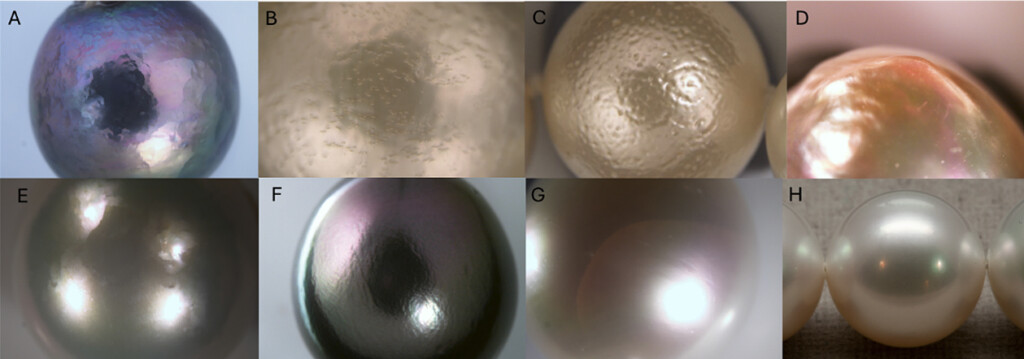
Some examples of surface and sub-surface nacre features that impact GIA’s new nacre classification scale. A: Near- or sub-surface “hammering.” B: “Bubble” appearance shown on the nacre surface. C: Shallow pits or channel depressions giving an “orange peel” effect. D: “Seam” found on a baroque pearl where surface planes meet or change direction and create a peaked ridge. E: “Planar edges” showing subtle angular lines spaced apart across the pearl’s surface. F: “Striae” features appearing as flame structures on a nacreous pearl. G: “Sub-surface crack” that may pose a threat to the durability of the pearl. H: An example of a pearl showing both a clean surface and excellent nacre (lacks any visible surface or sub-surface characteristics) based on the GIA 7 Pearl Value Factors. Photos by Emiko Yazawa (A–G) and Eric Welch (H); fields of view 19.27 mm (A and F), 7.19 mm (B), 14.52 mm (C, E, and G), and 9.61 mm (D).
One common feature found on the surfaces of pearls is hammering, named due to its hammered metal appearance (or faceted appearance), which exhibits distinct shallow dents or flats that are often seen on baroque pearls but can be present on any shape. This feature can make lustre appear softer than it is due to the dispersion of reflections.
As a near-surface or sub-surface feature, hammering can often be visible without magnification.
This surface feature is commonly associated with very rapid pearl growth, instead of a growth rate that can provide consistent regular crystal formation for a smooth nacre deposition throughout the whole growth period (Taylor 2008). Another feature commonly seen on some pearls is the internal fissures or cracks not far below the nacre surface that can be observed under strong lighting conditions (sometimes referred to as “tidelines”).
The figure below presents a good example of such a feature: a South Sea bead cultured pearl containing multiple internal cracks beneath the nacre surface. Under X-ray radiographic examination, these internal cracks can extend toward different directions between the bead nucleus and the nacre surface. 3D reconstruction of the X-ray computed microtomography data showed the extent of these cracks radiating from the bead substrate, providing a better visualization of how these internal fissures are distributed and interconnected with each other.
While drilling may occasionally cause internal cracks, undrilled pearls such as this example could also display these growth disruptions within their nacre layers, which may pose durability issues. The exact cause of this feature on undrilled pearls remains unknown.

LEFT: A South Sea bead cultured pearl displaying multiple “tideline” features under the surface. Photomicrograph by Emiko Yazawa; field of view 14.52 mm. CENTER: X-ray microradiograph of the pearl showing the cracks (indicated by arrows) extending from the bead substrate toward the surface. RIGHT: 3D reconstruction using X-ray computed microtomography data generated an overall 3D representation of the distribution of the internal cracks (in red).
Gemmological laboratory pearling observations
Contribution by the Bahrain Institute for Pearls and Gemstones (DANAT)
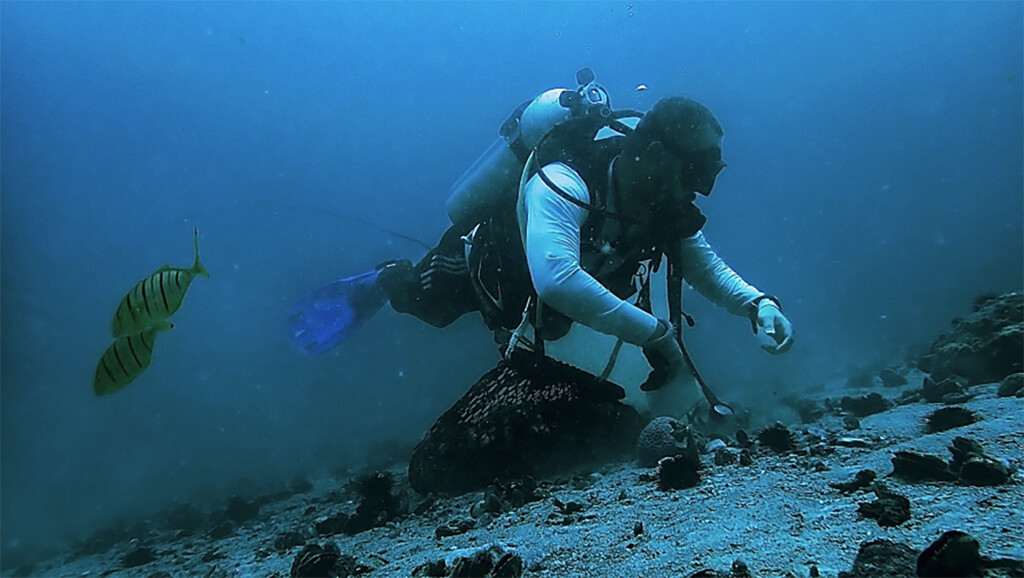
Pearl oyster sampling on the pearl oyster beds off Bahrain. (Photo: DANAT)
Blue carbon describes the natural process of capturing and storing carbon in coastal and marine ecosystems such as seagrass meadows and pearl oyster beds. Measuring this natural carbon storage is crucial for understanding ecosystem services, supporting climate change action, and enhancing long-term marine sustainability.
In April 2025, the Bahrain Institute for Pearls and Gemstones (DANAT), in collaboration with the Arabian Gulf University (AGU), launched a flagship research project to study the current and future impacts of climate change on Bahrain’s pearl oyster beds and seagrass ecosystems and their role in blue carbon sequestration and storage. The two-year project, which runs until the end of 2026, utilises advanced marine survey techniques, remote sensing, and laboratory analyses. This initiative is part of DANAT’s ongoing commitment to supporting scientific studies that enhance sustainability and reduce carbon emissions at both national and international levels.
The project is structured in two full survey and sampling cycles, with a combined total of over 300 marine surveys covering all waters of Bahrain. The first cycle was successfully completed in September 2025, while the second cycle will commence in December 2025 to complete the national-scale assessment.
The first phase was documented with rigorous field-based scientific reporting that highlights the marine biodiversity and ecological complexity of pearl oyster habitats, engaging specialists and experts in marine sciences, environmental chemistry, and remote sensing.
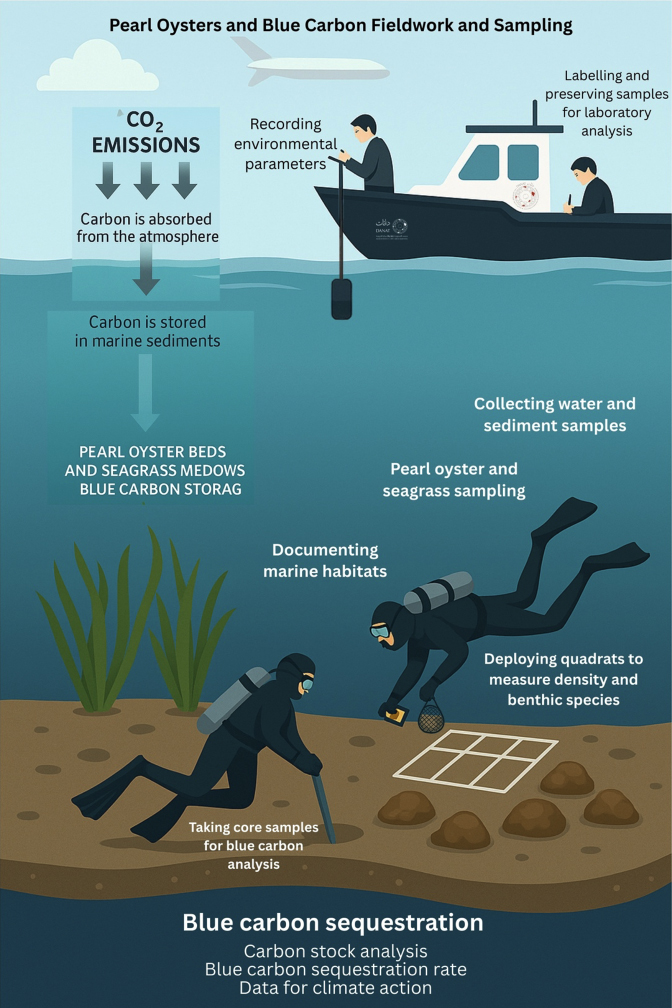
Key focus areas of the project include:
- Calculating and estimating blue carbon stocks within pearl oyster shells and tissues, and determining annual carbon sequestration rates (tons of CO2 per hectare per year), using advanced chemical analyses and remote-sensing data.
- Studying pearls and their composition, including internal structure and material properties, through comprehensive scientific analysis.
- Assessing the density and benthic-planktonic community structure of pearl oyster beds, and analyzing environmental factors affecting their distribution.
- Evaluating the effects of climate change, such as rising sea temperatures, salinity fluctuations, and ocean acidification, on pearl oyster growth and long-term resilience.
- Developing Habitat Suitability Index (HSI) models and future climate scenarios using GIS, satellite remote sensing, and Google Earth Engine platforms to guide habitat restoration and conservation.
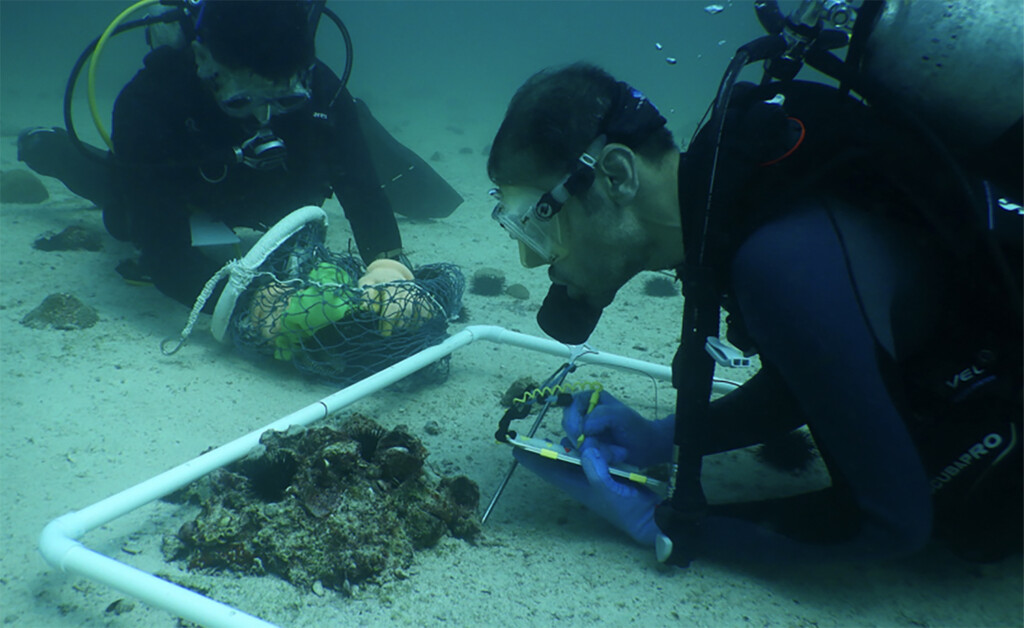
Underwater documentation by DANAT. The habitats surveyed and the marine assessments carried out during the project have showcased the vibrant marine life of the pearl oyster. (Photo: DANAT)
Pearl oysters represent a strategic ecological and economic resource, contributing to the marine ecosystem sustainability, biodiversity support and the high-end jewellery sector for which Bahrain is globally renowned.
The two-year project will strengthen specialized blue carbon research, highlighting the role of pearl oysters as a bridge between marine environmental conservation and the development of renewable, sustainable jewellery.
By providing key data to guide marine biodiversity protection and global climate goal, the project also highlights the contribution being made by the leading research and higher-education institutions in Bahrain, which together have reinforced the country’s leadership in blue carbon science. Findings from both cycles of the project will support sustainability efforts and the long-term resilience of Bahrain’s natural pearl sector and jewellery industry.
Beyond its environmental objectives, the project also feeds into a substantial scientific database that advances the national blue economy, supports carbon emission reduction strategies, and strengthens Bahrain’s position as a global hub for natural pearls and renewable, sustainable jewellery. It opens opportunities for future collaboration between research institutions, higher education and the private sector, fostering innovation across pearl-related value chains and reinforcing the synergies that exist between marine ecosystem conservation and green economic growth.
REFERENCES
Anonymous (1910), ‘Pearls and the pearl-fisheries of Bahrein’, Journal of the Royal Society of Arts, 59 (3032), 162-63.
— (1922), ‘Japanese production of cultured pearls’, Journal of the Society of Arts, 70 (3621), 394.
— (2024), ‘A Marine Pearl Farming Case Study for Regenerative and Restorative Aquaculture’, The Nature Conservancy, January.
Beckley, A.McC. (1934), ‘The scientists view of the cultivated pearl’, Gems and Gemology, 1 (2), 43-45.
Belgrave, C.D. (1934), ‘Pearl Diving in Bahrain’, The Journal of the Royal Central Asian Society, XXI (July), 450-52.
Calverley, E.E. (1917), ‘The pearl fishing in the Persian Gulf’, Scientific American Supplement, 83 (2146), 100-01.
Chidester, F.E. (1915), ‘The artificial production of pearls’, Scientific American Supplement, 79 (1915), 140.
Hardman, M.F., Homkrajae, A., Eaton-Magaña, S., Breeding, C.M., Palke, A.C., Sun, Z. (2024), ‘Classification of Gem Materials Using Machine Learning’, Gems & Gemology, 60 (3), 306–29,.
Iwahashi, Y. (2019), ‘Detecting Changes in the Ocean with “Kai-Lingual’, Ocean Newsletter, 5 September 2019 (458), 2.
Jameson, H.L. (1921), ‘Japanese culture pearls’, Nature, 108 (2721), 528-29.
Mikimoto, K. (1910), ‘Pearls of great price’, Overland Monthly, 60 (1), 83-84.
Mikimoto, V. (1921), ‘Processes for Causing Oysters to Produce Pearls’, UK 1577881921 (British).
Morelli, V., Faulk, A. (2023), ‘A Japanese Pearl Farm Shows Nature’s Artistic Process’, The New York Times.
Nagai, K. (2008), ‘Research on Means of Alleviating Damage by Heterocapsa circularisquama, Red Tides and Reddening Adductor Disease, Causes of the Mass Mortality of Japanese Pearl Oysters (Pinctada fucata martensii)’, Shinju Shinbun Sha.
Saville Kent, W. (1893), The Great Barrier Reef of Australia: its Products and Potentialities (2nd edn.; London: W. H. Allen).
Scarratt, K. (2019), ‘Les perles de Bahrein’, Revue de Gemmologie a.f.g., (208), 11-20.
Scarratt., K. (2019), ‘Natural Pearls from Bahrain’, Interenational Gemmological Conference – Open Colloquium (Nante).
Taylor, J., Strack, E. (2008), ‘Pearl Production’, in P.C. Southgate, Lucas, J.S. (ed.), The Pearl Oyster (Elsevier), 273–302.

